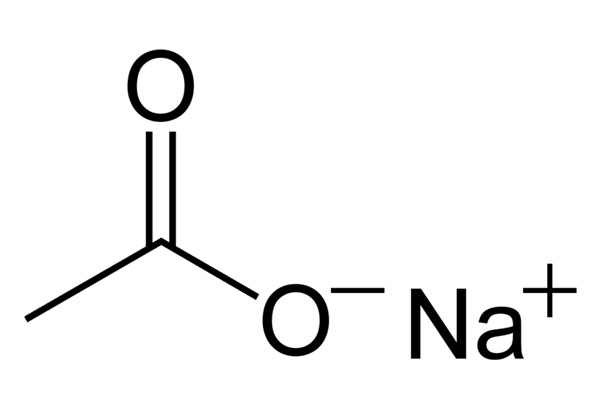Cas No: 127-09-3
EINESC No: 204-823-8
Molecular weight: 82.034 g/mol
Chemical Formula: C2H3NaO2
Chemical Structure:
Physical Properties
General Properties: white powder
Odor: odorless (similar to acetic acid in high temperatures)
Intensity: 1.528 g/cm3 (dehydrate), 1.45 g/cm3 (20 ° C, trihydrate)
Boiling point: 881,4 °C (dehydrate), 122 °C (trihydrate)
Melting point: 324 °C (dehydrate), 58 °C (trihydrate)
Flash point: 250°C
Vapor pressure:
Refraction index:
Solubility (aqueous) 123,3 (dehydrate), 46,4 (trihydrate) g/100 mL (20 ° C)
Viscosity:

General Properties
Sodium acetate is sodium salt of acetic acid and it is also known as sodium ethonoate. It usually looks like it is melting as it is extremely hygroscopic.
It does not pose a great threat in terms of health and it has a wide range of uses.
Production
Sodium acetate is industrially produced via reaction of trihydrate, acetic acid and sodium hydroxide. It is then disintigrated by water.
Applications
Sodium acetate is a frequently used salt. It is a safe carbon source for bacteria cultures in biotechnology and it is used to increase efficiency in DNA isolation. It is also used in dyes, chrome coatings and rubber production.
It is used as plum paste to reduce the damage water does to concrete. This process is both cheaper and environment-friendly.
In food production, it is used as food additive, spice. It gives vinegar and salt aromas and stabilizes pH. It is not hazardous to living beings in low concentrations.
Extremely saturated sodium acetate is used in heating pads that are used for climbing. It radiates warmth by crystallisig as exothermic.
Safety Measures and Toxic Values
Sodium acetate is irritant for eyes and skin. It is not hazardous unless taken in high concentrations. It should be kept away from fire sources as it can be mixed with any organic substance.